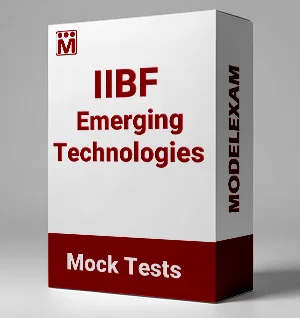IIBF Certificate Examination in Emerging Technologies - Exam Pattern, Syllabus, Eligibility & Fees
Emerging Technologies Mock Test

What is the objective of Emerging Technologies ?
The course on “Emerging Technologies” will help bankers to familiarise themselves with these new technologies and remain ahead of the learning curve.
ELIGIBILITY
1. Members and Non-Members of the Institute
2. Candidates must have passed the 12th standard examination in any discipline or its equivalent
Exam details
- (i) Question Paper will contain 100 objective type multiple choice questions for 100 marks.
- (ii) The examination will be held in the remote proctored mode only.
- (iii) There will NOT be negative marking for wrong answers.
The duration of the examination will be of 2 hours. Examination will be conducted on pre-announced dates published on IIBF Web Site.
Examination will be conducted in English only.
Passing Criteria
Minimum marks for pass in the subject is 50 out of 100.
Exam Fees – Rs 1100 for Members and Rs 1600 for Non Members (Plus applicable taxes)
Where will I get Emerging Technologies Model Question Papers?
MULTIPLE CHOICE QUESTIONS ( MCQs) AND ANSWERS
The Institute conducts its examinations through Multiple Choice Questions (MCQs). These MCQs are part of the Question Bank of the Institute and its Intellectual Property. As a matter of policy, these MCQs and their answers will not be shared by the Institute with the candidates or others and no correspondence in this regard will be entertained.
Syllabus for Certificate Examination in Emerging Technologies
Book 1:
Data Science: The Ultimate Guide to Data Analytics, Data Mining, Data Warehousing, Data Visualization, Regression Analysis, Database Querying, Big Data for Business and Machine Learning for Beginners by Herbert Jones.
Contents
Part 1 : Data Science
What the best Data Scientists know about Data Analytics, Data Mining, Statistics, Machine Learning, and Big Data – That You Don’t.
Introduction
Chapter 1: What is Data Science ?
Chapter 2: The Art of Data Science
Chapter 3: Data Science as a Change Agent
Chapter 4: Data Science Techniques
Chapter 5: Data Visualization
Chapter 6: Machine Learning for Data Science
Chapter 7: Data Science and Big Data Analytics
Chapter 8: Data Science Tools Towards Data Science
Chapter 9: Data Security – Protect Major Enterprise Assets
Chapter 10: Mastering Your Data with Probability
Chapter 11: Data in the Cloud
Chapter 12: Artificial Neural Networks
Chapter 13: Data Science Modeling and Featurization
Chapter 14: Five Mining Techniques Data Scientists Require for Their Own Toolbox
Chapter 15: The Concept of Decision Trees in Data Science
Conclusion
Part 2: Data Science for Business
Predictive Modeling, Data Mining, Data Analytics, Data Warehousing, Data Visualization, Regression Analysis, Database Querying, and Machine Learning for Beginners
Introduction
Chapter 1: What is Data Science?
Chapter 2: How Big Data Works in Data Science
Chapter 3: Explorative Data Analysis
Chapter 4: Working with Data Mining
Chapter 5: Data Mining Text
Chapter 6: Basic Machine Learning Algorithms to Know
Chapter 7: Data Modeling
Chapter 8: Data Visualization
Chapter 9: How to Use Data Science Right
Chapter 10: Tips for Data Science
Conclusion
Book 2:
Blockchain Evolution Explained A Beginners Guide to Understanding Blockchain Technology by Daniel Lincoln
Contents:
Chapter 1: What is a Blockchain?
Chapter 2: History and Evolution
Chapter 3: How Does Blockchain Work?
Chapter 4: Benefits of Using Blockchain Technology
Chapter 5: Downsides and Potential Dangers
Chapter 6: The Future of Blockchain Technology
Chapter 7: Frequently Asked Questions